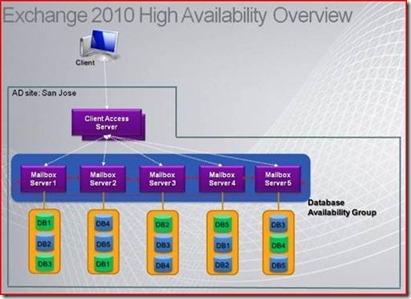Exchange 2010 SP1 Hosting – Part 1 “Overview”
In this series of posts I will go through Exchange 2010 SP1 Hosting details starting from Overview, Deployment, Migration, Multi-Tenant,...etc.
Microsoft Exchange Server 2010 SP1 supports hosting deployments and provides Hosting Partners the core feature-set of Exchange Server in a manner that can be deployed to multiple customers in a single installation, and provides ease of management and flexibility of provided features to end-users.
The hosting solution available for Exchange 2010 SP1 includes most of the features and functionality available in Exchange 2010 SP1 Enterprise deployments, but also includes features and functionality that will allow hosters to create and manage tenant organizations; however Exchange 2010 SP1 doesn't support the following features in Hosting mode:
- Exchange Management Console
- Public Folders
- Unified Messaging Server role
- Federation
- Business-to-Business features such as cross-premises message tracking and calendar sharing
- IRM (Information Right Management)
- Outlook 2003 support (EnableLegacyOutlook)
- Edge Transport Server role
The Exchange Server 2010 SP1 Hosting supports the following three separate server roles required to perform the tasks of a carrier-class messaging system
- Client Access Servers (CAS) - Support the traditional components such as Post Office Protocol 3 (POP3) and Internet Message Access Protocol 4 (IMAP4), Exchange ActiveSync®, Microsoft Outlook Web App, and Outlook Anywhere
- Hub Transport Servers (Hub) - Perform the internal message transfer, distribution list expansions, and message conversions between Internet mail and Exchange Server message formats
- Mailbox Servers (MBX) - Maintain mailbox store databases, with high availability provided by Database Access Groups (DAGs)
Flexible System Scaling Approach
Although it is technically possible to combine multiple Exchange 2010 server roles onto a single physical or virtual server, one of the goals of this Exchange 2010 SP1 Hosting architecture is to recommend against combining server roles. By implementing a single-role server deployment methodology, service providers can designate server hardware more accurately according to specific tasks, and increase the capacity of the messaging environment selectively, according to specific demands and changing trends. For example, as demand for mobile messaging services continues to grow, service providers can increase the number of Client Access servers without affecting other areas in the messaging environment
Role-Specific Load Balancing and Fault Tolerance and High Availability
Different server roles support different techniques and architectures for load balancing and fault tolerance. For example, if multiple Hub Transport servers exist in the same Active Directory® site, Exchange Server 2010 balances the message traffic automatically between these servers, whereas Mailbox servers are not load-balanced in the same way. Redundant copies of mailbox databases can be replicated across multiple servers arranged into Database Availability Groups (DAGs) to achieve fault tolerance.
Table below shows the load balancing technology per server role that service providers should use in a production environment to implement high availability and fault tolerance.
Server Role
Load Balancing Technology
Mailbox
Exchange Database Availability Groups (DAGs)
Hub Transport
Automatic load balancing through Mail Submission Service
Hardware load balancing for incoming mail connectivity
Client Access
Hardware load balancing
Exchange 2010 Data Base Availability Group (DAG)
The new concept of the Database Availability Group (DAG) is exciting Exchange 2010 technology to bring low cost high availability without costly hardware SAN infrastructure.
Microsoft Exchange Server 2010 clients will connect to Client Access Servers, which will proxy the requests to the client. No more LCR, SCR, or CCR…DAG (or Super CCR) uses low cost DAS storage to leverage a “Raid 5” striping of databases to multiple servers. Client Access Servers (set in load balanced server farms), will provide primary HTTP and a new “distributed RPC endpoint” for Office 2010, Office 2007 emulation of a “standard exchange mailbox server” without needing to upgrade the clients.
Since clients connect to the CAS servers to proxy requests to the mailbox servers, failover from mailbox server to another in the DAG happen in less than 30 seconds in a failover or move command.
Some other notable highlights in Exchange 2010 database and HA architecture:
- Replication between databases will change from being a RPC method, to a TCP socket method which will increase performance on heavily loaded servers.
- Replication can be locally or remote (cross-subnet). You will need CAS servers at the DR site however if you lose the primary datacenter.
- You can have to 16 mailbox servers in a DAG.
- There will be no integration with Microsoft Online at the DAG level. Microsoft Online cannot be used as DR site for a on-premise hosted mailbox. Either it’s on-premise or hosted, not a mixture of the two.
- You still Windows Server 2008 Enterprise, as failover clustering feature is required.
- The concept of Storage Groups is depreciated.
- Jet is still the storage engine for Exchange 2010 databases.
- Exchange IO has been reduced 50% from 2007 to 2010 (and already a 70% IO reduction from Exchange 2003 to 2007).
- Single Instance Storage is going away, as well as the per database table. A new table is created for each mailbox, creating the scenario for 10,000+ messages in mailboxes due to the sequential read capability.
- Server based PST files allows archiving with anywhere access. Helps for e-discovery, OWA searches, and compliance management.
In the next post I will go through Exchange 2010 SP1 Hosting description.
Related Posts:
- Exchange 2010 SP1 Hosting – Part 1 “Overview” https://blogs.technet.com/b/meamcs/archive/2010/12/31/exchange-2010-sp1-hosting-part1-overview.aspx?wa=wsignin1.0
- Exchange 2010 SP1 Hosting – Part 2 “Hosting Description” https://blogs.technet.com/b/meamcs/archive/2010/12/31/exchange-2010-sp1-hosting-part1-hosting-description.aspx?wa=wsignin1.0
- Exchange 2010 SP1 Hosting – Part 3 “Hosting Setup” https://blogs.technet.com/b/meamcs/archive/2011/03/14/exchange-2010-sp1-hosting-part-3-hosting-setup.aspx
- Exchange 2010 SP1 Hosting - Part 4 "Multi-Tenant Setup" https://blogs.technet.com/b/meamcs/archive/2011/05/15/exchange-2010-sp1-hosting-part4-multi-tenant-setup.aspx
